How to Make Pineapple Vinegar
Pineapple vinegar is made via a two-part fermentation process. First, yeast consume sugars within fruits to produce alcohol, known as alcoholic fermentation.
Second, acetic acid bacteria consume the alcohol from step one and convert it into acetic acid. Once all the alcohol is metabolized by bacteria and converted into acetic acid, you have vinegar.
To make pineapple vinegar at home, you first make wild pineapple wine, which then turns to vinegar! This two step process isn’t mutually exclusive and happen simultaneously.
What is Pineapple Vinegar?
Pineapple vinegar is just like any other fruit vinegar. It can be made from pineapple juice, pineapple fruit, or scraps.
It is traditional in Mexican cuisine and in many regions such as Zacatecas and Jalisco have used it for decades to make everything from hot sauces to chorizo. It’s essential in Mexican cuisine. (I learned this from @hechovistocomido on Instagram)
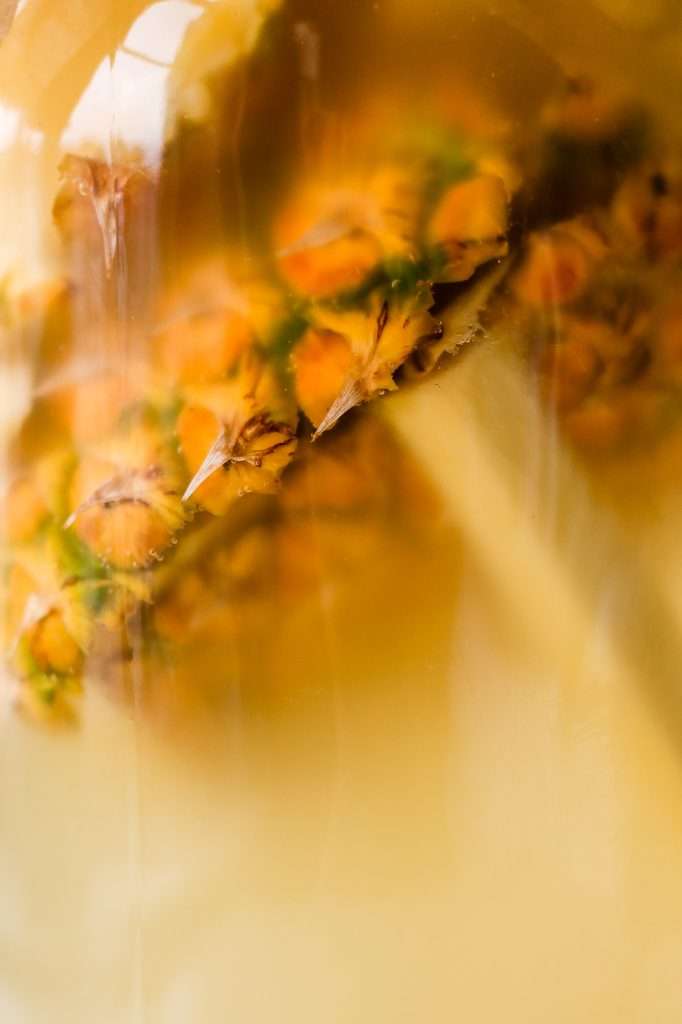
How to Make Vinegar from Pineapple
It is so easy to make vinegar with pineapple. You only need a few ingredients: pineapple scraps, sugar, raw vinegar (as a starter culture), and water. It’s important to use organic pineapple scraps in this recipe. Conventional pineapple is prone to kahm yeast which is no good for vinegar fermentation.
It helps if you have some raw apple cider vinegar with the mother as a starter, but it is not 100% necessary. It is possible to make pineapple vinegar with only pineapple scraps, water, and sugar.


What is a Vinegar Mother?
Vinegar “with the mother” is another name for raw vinegar containing all the microbes from the brewing process. So, think of the mother as microbial cultures. Vinegar mothers form cloudy floating pieces within the vinegar and a SCOBY on the surface.
A vinegar mother SCOBY looks similar to a kombucha SCOBY but is often lighter with varying textures. Vinegar mothers in homemade vinegar are always unique. No two will look exactly the same because the wild microbes from fruit scraps will be slightly different across batches. If it’s not chalky or fuzzy, it’s probably a perfectly normal mother.
You can use the vinegar mother SCOBY from your first batch of vinegar to culture the next batch of vinegar.
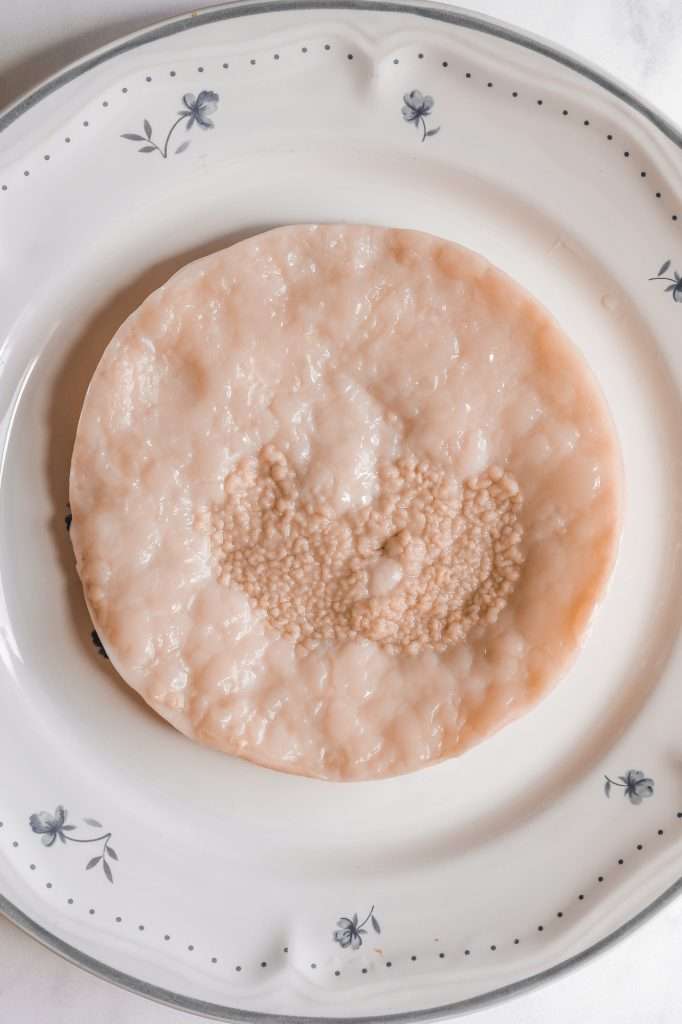
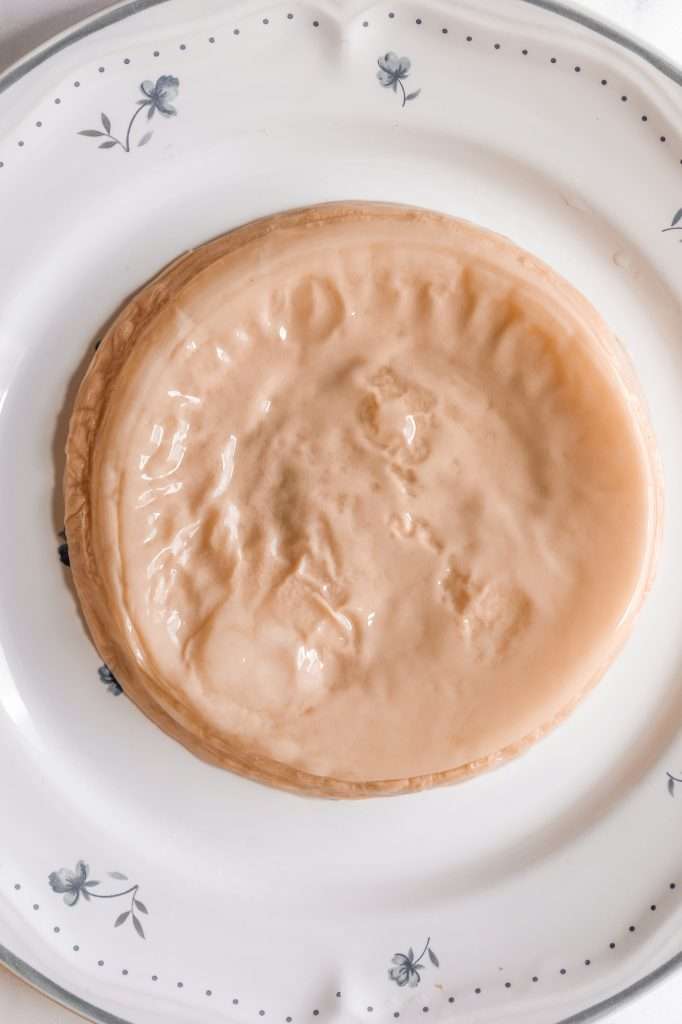
Equipment for Vinegar Fermentation
I suggest a gallon glass jar and a cloth cover with a rubber band for this recipe.
You must use a cloth lid when making vinegar because acetic acid bacteria require oxygen to convert alcohol into acetic acid. I usually make cloth lids for fermentation by cutting up old t-shirts.
Here is all the equipment you need:
- 1 gallon glass jar
- a cloth lid and a rubber band
- a kitchen scale
- large spoon (for stirring daily)
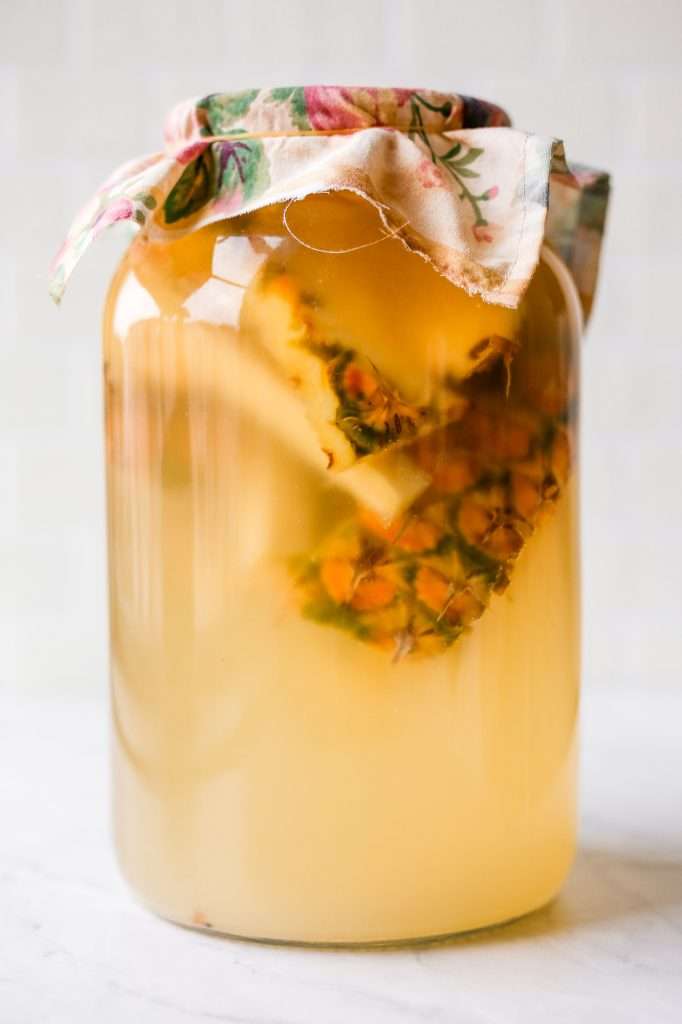
What Do You Use Pineapple Vinegar For?
I use my homemade pineapple vinegar in any recipe where I would use store-bought apple cider vinegar.
Pineapple vinegar may or may not be adequate for pickling and canning pickles. It depends on how ripe the pineapple is. To make a strongly acidic vinegar, use more sugar and scraps from very ripe and sweet pineapple. You can also add in some sulfite-free wine, tequila, or vodka in place of some of the water.
You can also test the pH with a pH strip to see if it is good for pickling/canning. Vinegar that is safe for pickling recipes should have approximately 2.4 pH (about 5% acidity).
Here are my favorite ways to use homemade vinegar:
- for homemade salad dressing
- in heirloom culturing recipes like this fermented green tomato recipe
- I love to drizzle it over honeydew melon with raw honey and a pinch of salt.
- In mineral-rich hydrating drinks (I like to mix a tablespoon of fruit vinegar into a quart of water with a splash of coconut water, orange juice, and a pinch of sea salt for a homemade hydrating “Gatorade”)
- You can also use homemade vinegar in Oxymel and Fire Cider recipes.
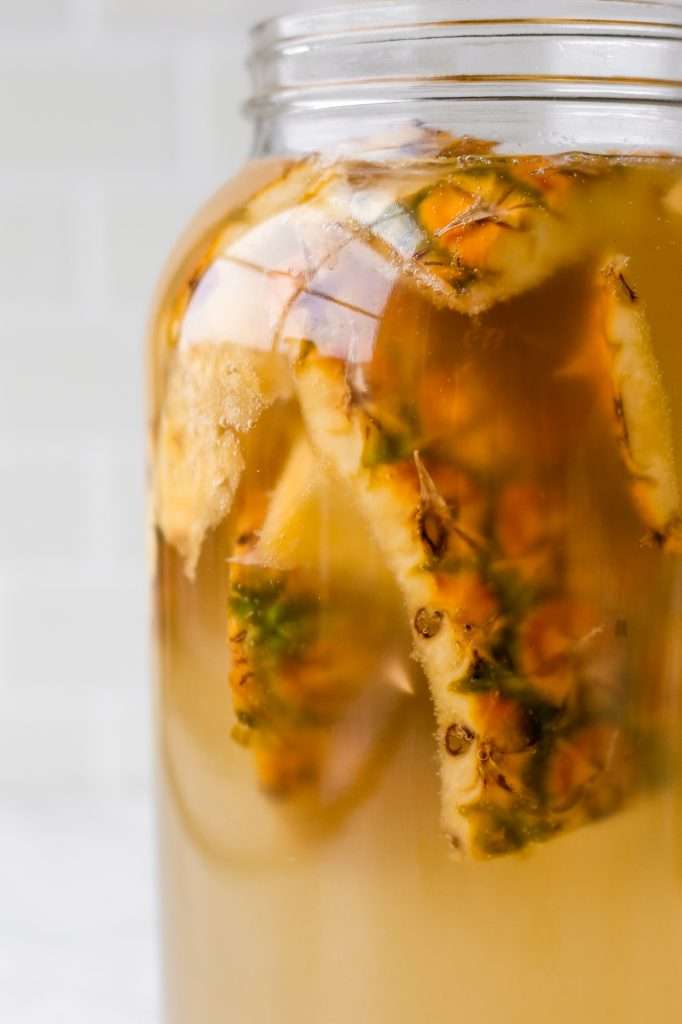
Homemade Pineapple Vinegar
The keys to remember when making pineapple vinegar or any fruit vinegar at home:
- Stir the vinegar once daily. Remove the cloth lid, give it a good stir, replace the lid, and repeat daily until you strain the vinegar.
- You must use a breathable cloth lid. The microbes involved in vinegar production require oxygen to convert alcohol to acetic acid.
- Use a clean glass container. It is best to use glass when fermenting acidic vinegar. Clean your equipment well before getting started.
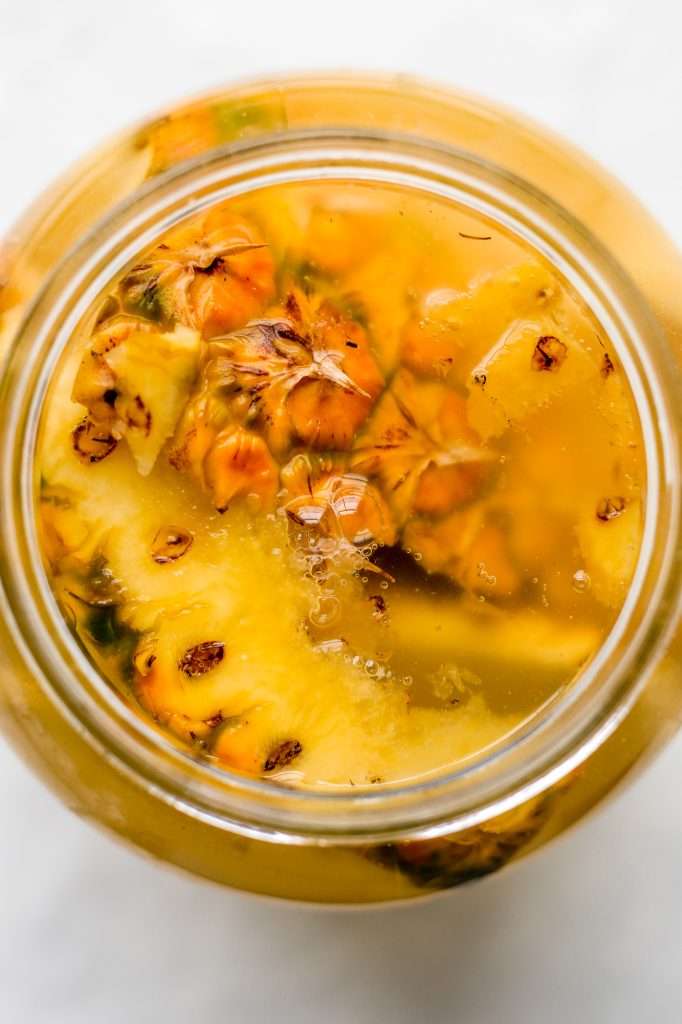

How to Make Pineapple Vinegar from Pineapple Scraps
My easy pineapple vinegar recipe requires only four ingredients: pineapple scraps, sugar, raw vinegar for a starter culture, and water. This is the perfect recipe to use up pineapple scraps.
- Prep: 10 minutes
- Total Time: 1512 hours 10 minutes
Ingredients
- 6 cups ripe, organic pineapple scraps* chopped
- 255 grams of organic cane sugar
- Water
- 3 tablespoons raw vinegar with the mother*
- 1 gallon glass jar
- cloth covering
- rubber band
Instructions
- Please read the recipe notes.
- Wash the pineapple rind well with warm water. Chop the pineapple scraps into chunks.
- Add the sugar and pineapple to a 1-gallon glass jar.
- Add water to the jar until full.
- Add in a few tablespoons of raw vinegar with the mother. This is your starter culture and helps establish a good microbial community (see notes below)
- Stir the mixture until all the sugar is dissolved.
- Place a cloth lid on the jar and secure with a rubber band.
- Stir the mixture once or twice a day and allow to ferment at room temperature for three weeks. Don’t forget to stir it. I like to just do it first thing in the morning each day.
- You should notice the mixture bubble within one week.
- After three weeks of fermentation, strain out all the pineapple pieces, replace the cloth lid and allow the mixture to ferment for 6 more weeks.
- You will notice a vinegar mother form on the surface (it looks like a kombucha SCOBY but is very light in color). You can keep this to start your next batch of vinegar.
- After fermentation, bottle the vinegar and seal it with a solid lid. Store at room temperature in your pantry.
Notes
- Vinegar works best with a starter culture. While it is possible to make vinegar without it, adding a vinegar mother or raw apple cider vinegar with the mother to the mixture ensures success. If you have a kombucha SCOBY or raw kombucha, you can sub for that with good results.
- For very strong vinegar, you can also add in some sulfite-free wine, tequila, or vodka in place of some of the water.
- You should use RIPE organic or homegrown pineapple scraps in this recipe. Conventional pineapple is prone to kahm yeast, which is not suitable for vinegar fermentation.
- If you’ve had trouble with kahm yeast when making vinegar, try boiling all the ingredients then allowing it to cool before adding the raw vinegar with the mother starter culture.




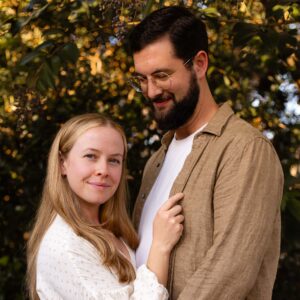
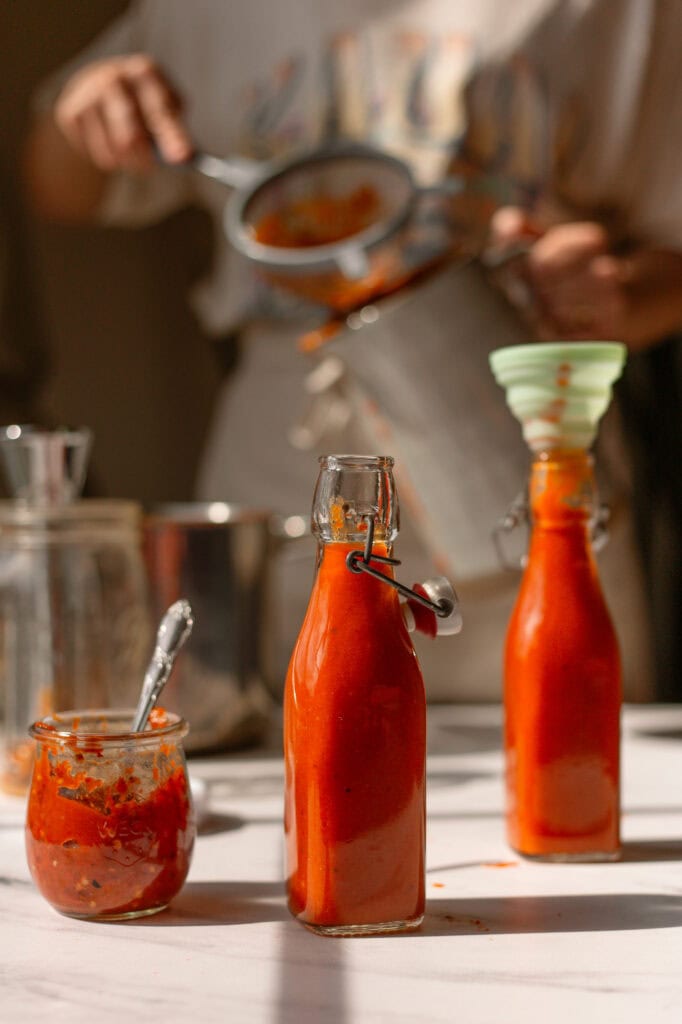
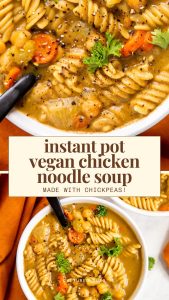














Question: as a starter can i use other things like brine from a fermented vegetable (I have sauerkraut at hand) or a bit of kefir water?
So glad you asked before doing this because, no! Absolutely not. Kombucha and vinegar contain the same groups of microbes (yeasts and acetic acid bacteria) so you can use kombucha here. Things like fermented vegetables and kefir contain completely different groups of microbes (lactobacilli) so those will not work at all for vinegar.
Hello i loved doing your recipe for pinneaple vinegar , but started to get a lot of questions as something apparently kahm yeast has formed and the vinegar turned from yellow to dark amber color and there is no mention in the recipe or pictures of things like this that can happen and i dont know of i should throw it out and i have sent multiple questions on dms and comments in instagram over months and no reply i think this is something very important to mention in the recipe some people dont get stuck with some weird jars not knowing what to do like me or maybe open a subscription for Q&A’s for those of us who cant afford right now the course
Thanks for the feedback. I do not answer DMs on social media. You can ask your questions, for free, here in the comments of these free recipes that I work very hard to provide. If you follow the directions and use quality ingredients then you shouldn’t encounter any issues.
Thanks for sharing this recipe! So far so good with my vinegar. Just want to make sure I’m doing this right. I’ve strained out the pineapple pieces. At this point, should I stop stirring? I imagine that’s the only way to slow the Scott to form, right? Thanks!
No need to stir it once the fruit is strained. And correct, you don’t stir it anymore so the SCOBY can form.
When I replace the lid at the 3 week mark, do I replace it with a new CLOTH LID or a Sealed lid for the remaining 6 weeks?
Put the same cloth lid back on the jar.
It’s early to tell how this will turn out as I only started it yesterday. I only bought one pineapple so I had only 1/4 the amount of scrap needed so I cut the recipe in 1/4 and used a 32 ounce jar. So hopefully it’s fine to Reduce the recipe. A gallon would be way more than I would have wanted especially on the first attempt, in case we don’t end up liking it.
If a mother forms before the 3 week mark should I strain the fruit earlier?
You can, but you don’t need to. You can just proceed with the recipe.
Hi there- a few q’s!
1. I attempted pineapple vinegar and followed instructions to a T. It looked great and then I strained it out to let it continue to ferment. Then it just did nothing. Never turned to vinegar, no mother formed. Any ideas what happened here?
2. I think my apple scrap vinegar is tasting pretty good, but it never appeared to grow a mother. There is some thicker stuff at the bottom of the jar but I assumed it was just residue. Does it need to have a mother to be finished?
3. Is Kahm yeast bad? I think my plum vinegar is growing kahm yeast but I can’t quite tell.
Thank you!
hello!
1. You can add some more raw vinegar starter and let it sit longer. You wont really see anything happen after you strain it, but a mother usually forms eventually. It should smell sour like vinegar and taste tart.
2. Glad to hear the apple vinegar is going well. There wont always be a mother, but if you want one, you can always add a bit more raw vinegar with the mother (or raw kombucha) after straining and one should grow.
3. Kahm yeast isn’t necessarily bad, but it can mess up the vinegar process. Stone fruits don’t work well for vinegar because they contain high levels of the fermentable sugar sorbitol, which kahm yeast loves.
I made this and it just finished. It tastes amazing and is my favorite vinegar I have ever had. I’ll definitely be making a gallon next time. I’ve been mixing it with sparkling water and tinctures and it’s really good. I’m sure it will make good salad dressings and good to add to stir fries, too. It’s quite versatile and sweet tasting.
Glad to hear you love the pineapple vinegar! It’s my favorite too.
I am getting ready to start the process. My question is can you freeze your fruit before you start? Example if I don’t have enough fruit or scraps, can I save them in freezer until I have enough or will it “kill” the fruit?
If this is ok, then you could use any frozen organic fruits (except large pitted fruit). Citrus, too?
You can freeze it! The raw ACV is a starter culture, so you don’t need the wild microbes on the pineapple skins.
Omg! Thank you so much for this recipe. Me and my wife have a tent at our local farmers market and we sell elderberry syrup and fire cider. This will make a great addition to our table. The vinegar came out perfect. We added honey and it is so delicious and the health benefits our amazing .. thank you
When it’s in it’s alcohol state, would it be a drinkable pineapple wine?
Not exactly. It might be a little like sour wine but I’ve never tried it.
I’ve been doing more reading since asking my initial question… Without using raw vinegar or a mother it would be more like a fermented soda or fruit scrap “kvass” within 2-7 days. Which I’m actually really excited about! I’ve been looking to make non-alcoholic fizzy drinks with fruit scraps that don’t have a long fermentation period.
Hello! I am following your recipe and am currently at week 2 of 6 of letting it sit on the counter without stirring. But I have mold (it’s got blue in it, so I don’t think it’s Kahn yeast) forming on the top. I read this may be because it’s not acidic enough. Do I need to throw this out? Is there a way to make it more acidic at this point? Thanks!
If there is mold you should throw it out! Did you follow the recipe precisely and did you use organic pineapple?
Oh, no. We did not use organic. We followed the entire thing precisely except for that part so I’m sure that’s the problem. We will have to try again with organic! Thank you for the reply!
I just started my very first batch of vinegar, thank for sharing.
I’m one week into the process, I’ve been stirring every day, and a couple of days ago, nice bubbles started forming. I was thrilled. This morning when I took off the cotton top, I saw “stuff” on top. It’s whitish and bubbly and there may be some yellow stuff on top, too. It’s only on top of the floating pineapples, but it’s covering the whole top. Nothing fuzzy or blue or green. Is this kahm yeast? If so, what do I do? Do I continue to stir or do I skim it off? (I wish I could attach a picture!) Thanks for any advice.
It might be a mother trying to form! You can email me a picture to [email protected] if you want.
Hello, I am getting ready to make some of this vinegar. I have everything ready and will make it tomorrow. I fell in love with making pickled everything years ago and recently had some curtido from a Salvadoran restaurant. I have been making it with carrots, cabbage and onions, peppers and spices. When I looked up how to make curtido it brought me to making pineapple vinegar. Can’t wait to see the results, but a few questions:
Can I use honey instead of sugar, and how much should I add.
Can I use coffee filters instead of a cloth covering.
Thank you so much!
yes! you can use honey. Honey makes great vinegar and you can evenly sub it for the sugar. and a coffee filter secured with a rubber band will work great.
Hi Kaitlyn, I started making the pineapple vinegar however, I have a question. My pineapple vinegar was bubbling really well for the first week. Then the second week it stopped. I stirred my vinegar everyday to prevent kahm yeast. After 2 weeks it still developed kahm yeast. So, I strained it earlier than 3 weeks. Will this affect the end result ? Will it turn to vinegar? Will the kahm yeast return? Thank you!
Are you using organic or homegrown pineapple? It seems that people who get kahm yeast usually are using conventional pineapple from the grocery store.
Can I substitute raw honey for the sugar?
yes
Thank you so much for your quick response!
Hey there! I’m making this pineapple vinegar and I’m three weeks in. I used organic pineapple and have followed your instructions religiously. It looks like a very thin layer of claim yeast might be forming, but it could be a mother trying to form. How can I tell? This is my first fermentation so I appreciate the help!
hey! Kahm yeast looks very chalky and powdery, while a scoby forming looks more smooth and opaque. You can email me a picture to [email protected] and I’ll tell you what I think!
Is there anything you can do if you do get kahm yeast on top?
Not much you can do to fix it after it happens, that’s why I emphasize preventing it. Did you use organic pineapple?
I truly don’t recall. Thanks tho.
Hello Kaitlynn, I have followed the recipe, and strained the pineapple out seven weeks ago. The result still smells like yeast, no hint of vinegar smell yet. Should I continue to wait, or is it beyond hope? Thank you.
I’d say wait longer and see how it develops and if a mother scoby forms on the surface.
Thh he a k you so much for this recipe. I love it. I made my first two batches this summer. I tested the ph today and it’s finally at 5%. I plan on using it to make my homemade jalapeño jam.
My question is…. My mother isn’t floating in either jar. They are both settled on the bottom. Is that normal?
Also one is more cloudy as for the other is more clear looking obviously with a yellow tint to them.
Thank you again and in advance for your help.
The mother doesn’t have to float! It’s perfectly fine if it sinks to the bottom. When is sinks to the bottom, another will likely form on the surface. Also, color variations are normal in naturally fermented foods.
Hi! Do I have to use organic cane sugar or can I use regular granulated sugar (e.g. from domino)?
It’s best to use organic sugar. Oftentimes conventional sugar has a lot of herbicides and fungicides in it that mess with fermentation.
I made this recipe from regular store bought pineapple. I just strained out the pineapple chunks &set aside for the 6 weeks. Questions:
When would Kahm yeast
appear ?
Could I use filtered or bottled water to rinse the chunks & add that to the vinegar (for the 6 weeks) ?
I tasted a small chunks & it was vinegary strong & good ! Excited to taste the final product in 6 weeks !
The next step is the final strain before bottling?
Thank you for the simple recipe. I’ll definitely do it again.
Hello! You should follow the recipe as written for best results. Once it’s strained you should leave it without fruit pieces in it. Glad you enjoyed the recipe and will make it again!
I did my best to follow your recipe.These questions arose as I was doing so;as I was straining/draining out the fruit,I wondered if I could rinse the fruit & add it in also. But no worries;I think I did ok.The result is only have a quart of “vinegar”to set aside for the 6 weeks.Its a beautiful/dense golden color;not thin or see they. May I send you pics of my “vinegar”?
Gracias por la receta, pruebo y le doy la calificación. Un saludo
Hello, big fan here 🙂 I started the pineapple vinegar this 7/31 and it already seems to be developing kahm yeast -not much, but still visible. I am surprised, because I’ve made tepache many times with no problem. Should I continue to try and make pineapple vinegar or don’t even bother and go for tepache instead?
That’s up to you. Did you use organic pineapple?
Yes, I used organic pineapple, ACV and brown sugar. I cleaned everything I used. Rinsed the pineapple thoroughly with warm water and all the utensils were washed with soap. I didn’t sterilize. What would you recommend I do? Leave it as tepache or continue to try for vinegar? I know you said the scoby wouldn’t form with the kahm yeast. It’s been 12 days, I’ve been mixing it every day.
Hi again, I decided to continue with the experiment and make pineapple vinegar. It should be done by the end of this month.I know you said kahm yeast could prevent the scoby from forming, which hasnt happened, however, it smells and looks good. Any idea if it’s still good? I was planning on using it to make shrubs.
Thanks!
Saya mencoba membuat cuka nanas tanpa stanter, hanya nanas, air dan gula, skr msh berjalan 2 Minggu, dan air hasil fermentasi berwarna keruh, tapi semoga hasil percobaan saya berhasil.
hello! i was hoping to ask for some assistance. i followed this recipe to a T (for a science fermentation project) but haven’t seen any mother vinegar forming. it’s only been 18 days in the fermentation process, but i’ve strained the pineapple scraps out to hopefully let the vinegar sit and the mother to eventually form. am i doing the right thing? so far, no mold has formed, but it did stop showing signs of any reaction after the first week of fermentation. ㅠㅠ
The liquid should be cloudy and smell like alcohol and acetic acid, which are both signs of an active vinegar mother forming. The the vinegar mother pellicle is only able to grow on the surface once you strain it and stop stirring it. So it makes sense that it hasn’t grown yet. Sounds like you’re following the directions and everything is fine. Now that you’ve strained it, leave it alone covered with a cloth lid, and the pellicle should eventually grow on the surface.
thank you so much, i owe you my life (and my grades teehee)! will the mother be able to grow in less than 6 weeks?
Hi! I’m getting ready to try this and I only have enough scraps to make a half gallon. Can I just half your recipe? Thx! ☺️
for sure!
Çok güzel bir tarif yapmışsınız çok teşekkür ederim yazınızı okuyunca bu işi bildiğiniz anladım bu konuyla ilgili web üzerinde en güvenilir bilgi sizin verdiğiniz bilgi olduğuna kanaat getirdim tekrar teşekkürler
Hi Kaitlynn, I have some issues about making pineapple vinegar here. A few weeks after the scraps have been strained and the mother has formed, I got mold on the surface of my vinegar mother. It has happened twice. What could be the reason of this issue? Thank you really appreciate if you can help me with this 🙂
sounds like a contamination issue! Are you removing the cloth lid and putting it back on for any reason? Make sure there is no lint or dust on the lid. The only time I’ve ever had mold after the mother forms on the surface, is from lint and dust on the cloth lid floating down onto the mother/pellicle.
How often should I change the cloth lid? Should it be every week or every 2 weeks? I changed the cloth lid after straining the scraps but haven’t changed it again. My bad 🙁
I usually just change it if I take it off for any reason. That way when I put a lid back on I don’t introduce any dusty bits into the mix.